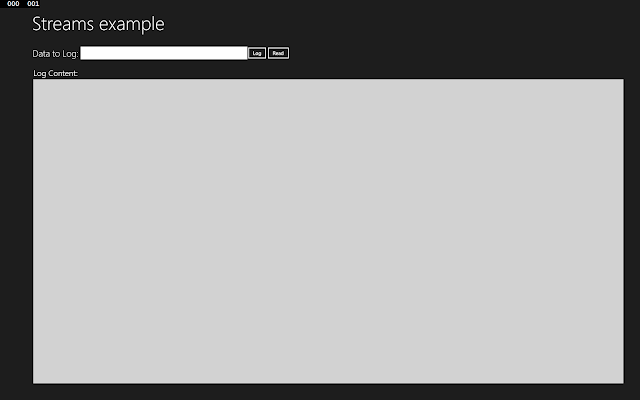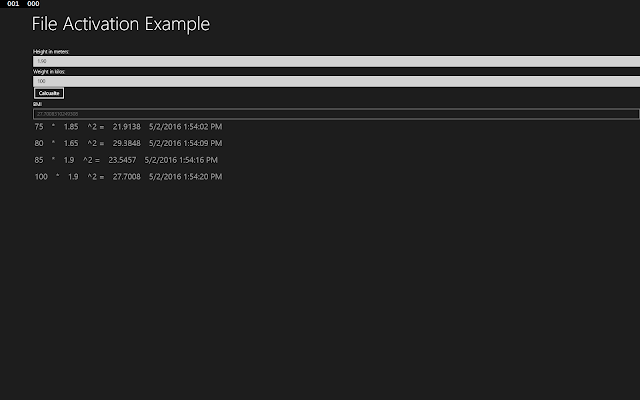https://msdn.microsoft.com/en-us/library/k3352a4t(v=vs.110).aspx
basically anything stored in your computer is either a 1 or 0 (quantum computing aside), so whether your data is text, numbers, music, image's videos whatever at the end of the day it's represented by 1's and 0's or binary.
streams just let us stream those 1's and 0's; we can transform them or just read and write them, anyway here are some quick examples, let's start with a UI
<Page
x:Class="pc.StreamsExample.MainPage"
xmlns="http://schemas.microsoft.com/winfx/2006/xaml/presentation"
xmlns:x="http://schemas.microsoft.com/winfx/2006/xaml"
xmlns:local="using:pc.StreamsExample"
xmlns:d="http://schemas.microsoft.com/expression/blend/2008"
xmlns:mc="http://schemas.openxmlformats.org/markup-compatibility/2006"
mc:Ignorable="d">
<Grid Background="{ThemeResource ApplicationPageBackgroundThemeBrush}">
<Grid.RowDefinitions>
<RowDefinition Height=" 140" />
<RowDefinition Height="auto"/>
<RowDefinition Height="*"/>
</Grid.RowDefinitions>
<TextBlock Grid.Row="0" Text="Streams example"
Margin="100 0 0 0"
VerticalAlignment="Center" Style="{ThemeResource HeaderTextBlockStyle}"
/>
<StackPanel Grid.Row="1"
Orientation="Horizontal" Margin="100 0 0
0">
<TextBlock Text="Data to Log:"
Style="{ThemeResource SubheaderTextBlockStyle}" />
<TextBox Margin="10 0 0 0" x:Name="input_TXT" Width="500"/>
<Button x:Name="log_BTN" Content="Log" />
<Button x:Name="read_BTN" Content="Read" />
</StackPanel>
<TextBox x:Name="Log_TXT" Grid.Row="2" Margin="100 20 50 50"
Header="Log
Content:" FontSize="24"
TextWrapping="Wrap" AcceptsReturn="True"
/>
</Grid>
</Page>
next lets look at our code behind and try to log some data:
using System;
using System.IO;
using System.Runtime.InteropServices.WindowsRuntime;
using Windows.Security.Cryptography;
using Windows.Storage;
using Windows.Storage.Streams;
using Windows.UI.Xaml;
using Windows.UI.Xaml.Controls;
namespace pc.StreamsExample
{
public sealed partial class MainPage : Page
{
public MainPage()
{
this.InitializeComponent();
this.log_BTN.Click += log_BTN_Click;
}
async void log_BTN_Click(object sender, RoutedEventArgs e)
{
var lineItem = String.Format("{0}:
{1}\r\n", DateTime.Now.ToString("dd-MM-yy hh:mm:ss"), input_TXT.Text);
IBuffer line = CryptographicBuffer.ConvertStringToBinary(lineItem, BinaryStringEncoding.Utf8);
//require
picture library capability in our app manifest
var Pictures = KnownFolders.PicturesLibrary;
var logFile = await Pictures.CreateFileAsync("log.txt", CreationCollisionOption.OpenIfExists);
await FileIO.WriteBufferAsync(logFile, line);
}
}
}
swap the following line
await FileIO.WriteBufferAsync(logFile, line);
With
await FileIO.AppendTextAsync(logFile, lineItem);
there we go, with that small change we're now appending our file at the end instead of overwriting it. next let's add our read event in our constructor
public MainPage()
{
this.InitializeComponent();
this.log_BTN.Click += log_BTN_Click;
this.read_BTN.Click += read_BTN_Click;
}
async void read_BTN_Click(object sender, RoutedEventArgs e)
{
StorageFolder Pictures = KnownFolders.PicturesLibrary;
StorageFile logFile = await Pictures.GetFileAsync("log.txt");
Log_TXT.Text = await FileIO.ReadTextAsync(logFile);
}
async void log_BTN_Click(object sender, RoutedEventArgs e)
{
var lineItem = String.Format("{0}:
{1}\r\n", DateTime.Now.ToString("dd-MM-yy hh:mm:ss"), input_TXT.Text);
IBuffer line = CryptographicBuffer.ConvertStringToBinary(lineItem, BinaryStringEncoding.Utf8);
//require
picture library capability in our app manifest
var Pictures = KnownFolders.PicturesLibrary;
var logFile = await Pictures.CreateFileAsync("log.txt", CreationCollisionOption.OpenIfExists);
using (var s = await logFile.OpenStreamForWriteAsync())
{
s.Position = s.Length;
s.Write(line.ToArray(), 0, Convert.ToInt32(line.Length));
}
}
async void read_BTN_Click(object sender, RoutedEventArgs e)
{
StorageFolder Pictures = KnownFolders.PicturesLibrary;
StorageFile logFile = await Pictures.GetFileAsync("log.txt");
using (var stream = await logFile.OpenReadAsync())
using (var inputStream = stream.GetInputStreamAt(0))
{
var dr = new DataReader(inputStream);
uint numBytesLoaded = await dr.LoadAsync((uint)stream.Size);
Log_TXT.Text = dr.ReadString((uint)numBytesLoaded);
}
}
async void log_BTN_Click(object sender, RoutedEventArgs e)
{
var lineItem = String.Format("{0}:
{1}\r\n", DateTime.Now.ToString("dd-MM-yy hh:mm:ss"), input_TXT.Text);
IBuffer line = CryptographicBuffer.ConvertStringToBinary(lineItem, BinaryStringEncoding.Utf8);
//requrie
picture library capablity in our app manifest
var Pictures = KnownFolders.PicturesLibrary;
var logFile = await Pictures.CreateFileAsync("log.txt", CreationCollisionOption.OpenIfExists);
using (var fileStream = await logFile.OpenStreamForWriteAsync())
using (var outputStream = fileStream.AsOutputStream())
{
fileStream.Position =
fileStream.Length;
DataWriter dw = new DataWriter(outputStream);
dw.WriteBytes(line.ToArray());
await dw.StoreAsync();
await outputStream.FlushAsync();
}
}
async void read_BTN_Click(object sender, RoutedEventArgs e)
{
StorageFolder Pictures = KnownFolders.PicturesLibrary;
StorageFile logFile = await Pictures.GetFileAsync("log.txt");
using (var stream = await logFile.OpenReadAsync())
using (var inputStream = stream.GetInputStreamAt(0))
{
var dr = new DataReader(inputStream);
uint numBytesLoaded = await dr.LoadAsync((uint)stream.Size);
Log_TXT.Text = dr.ReadString((uint)numBytesLoaded);
}
}






